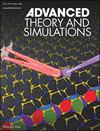利用不同载流子传输层的cu3bis3基薄膜PV电池的理论启示
IF 2.9
4区 工程技术
Q1 MULTIDISCIPLINARY SCIENCES
引用次数: 0
摘要
近年来,Cu3BiS3化合物由于其1.24 eV的良好带隙、丰度、高的吸收系数和具有成本效益的生产能力,在太阳能电池中作为吸收层材料具有很大的应用潜力。本研究利用SCAPS 1D软件对各种Cu3BiS3异质结构太阳能器件进行了详细的模拟。将CdS、In2S3、Zn(O,S)和ZnSe化合物与Cu3BiS3一起作为电子传递层(ETLs)来确定最佳条件。n-ZnSe/p-Cu3BiS3结构优于CdS、In2S3和Zn(O,S) etl,其短路电流(JSC)为31.38 mA cm−2,开路电压(VOC)为0.80 V,填充系数(FF)为81.49%,功率转换效率(PCE)为20.45%。另一方面,添加不同的后表面场(BSF)层,如AlSb、BaSi2、CGS和PEDOT:PSS,使JSC、VOC和FF更高,最终改善PCE,使用AlSb、CGS、BaSi2和PEDOT:PSS作为BSF层,VOC在0.92 ~ 0.96 V范围内升高。每个BSF层的存在使电流增加约5 mA cm−2。最后,对于AlSb, CGS和PEDOT:PSS BSF, Cu3BiS3器件的PCE上升到≈29.25%,对于BaSi2 BSF, PCE上升到28.69%。本文章由计算机程序翻译,如有差异,请以英文原文为准。

Theoretical Revelation of Cu3BiS3-Based Thin Film PV Cell Exerting Various Carrier Transport Layers
Recently, Cu3BiS3 compound has exhibited great potential as a material for the absorber layer in solar cell applications owing to its favorable bandgap of 1.24 eV, abundance, high absorption coefficient, and capacity for cost-effective production. This study demonstrates the detailed simulation of various kinds of Cu3BiS3 heterostructured solar devices using SCAPS 1D software. The CdS, In2S3, Zn(O,S), and ZnSe compounds are employed as electron transport layers (ETLs) in conjunction with Cu3BiS3 to determine the optimal condition. The n-ZnSe/p-Cu3BiS3 structure outperforms CdS, In2S3, and Zn(O,S) ETLs by providing a short circuit current (JSC) of 31.38 mA cm−2, an open circuit voltage (VOC) of 0.80 V, an 81.49% fill factor (FF), and a power conversion efficiency (PCE) of 20.45%. Adding different back surface field (BSF) layers, such as AlSb, BaSi2, CGS, and PEDOT:PSS, on the other hand, makes JSC, VOC, and FF much higher, which eventually improves PCE. Use of AlSb, CGS, BaSi2, and PEDOT:PSS as BSF layers raises the VOC in the range of 0.92 to 0.96 V. The presence of each BSF layer boosts the current by ≈5 mA cm−2. Finally, the PCE of Cu3BiS3 devices rise to ≈29.25% for AlSb, CGS, and PEDOT:PSS BSFs, and 28.69% for BaSi2 BSF.
求助全文
通过发布文献求助,成功后即可免费获取论文全文。
去求助
来源期刊

Advanced Theory and Simulations
Multidisciplinary-Multidisciplinary
CiteScore
5.50
自引率
3.00%
发文量
221
期刊介绍:
Advanced Theory and Simulations is an interdisciplinary, international, English-language journal that publishes high-quality scientific results focusing on the development and application of theoretical methods, modeling and simulation approaches in all natural science and medicine areas, including:
materials, chemistry, condensed matter physics
engineering, energy
life science, biology, medicine
atmospheric/environmental science, climate science
planetary science, astronomy, cosmology
method development, numerical methods, statistics
 求助内容:
求助内容: 应助结果提醒方式:
应助结果提醒方式:


